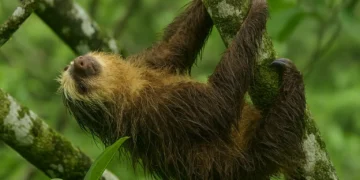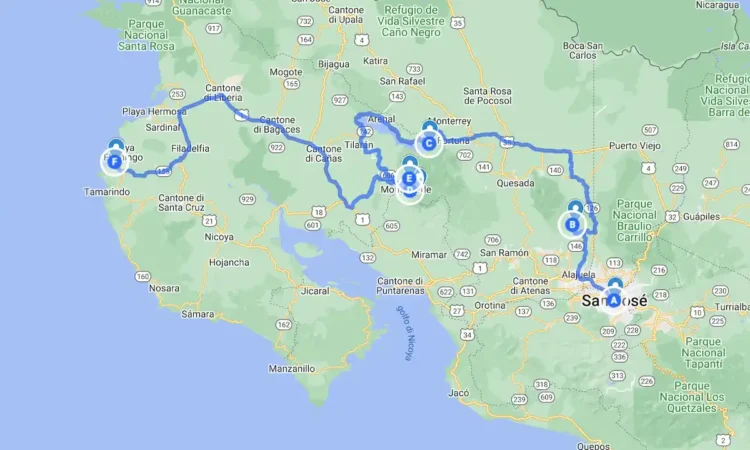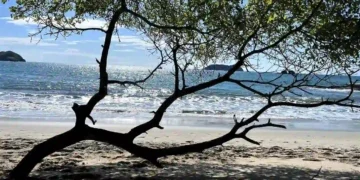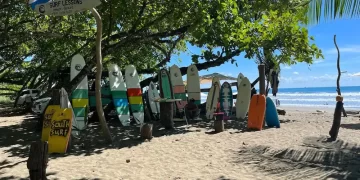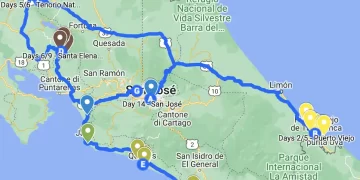What to see in Costa Rica in 7 days: a short itinerary for those with limited time
As you can imagine, it is very difficult to decide what to see in Costa Rica in 7 days, mainly because the wonders of this country are really many and, in addition, the morphology of the territory is definitely varied. Given the limited time available, we advise against traveling by public transportation, as often a single leg can take up to 6 hours.
Before you plan your trip, however, we recommend that you carefully choose in which season you intend to visit Costa Rica: that is why we have thought of planning two itineraries suitable for the dry and wet seasons. In any case, if you have the chance, we suggest you take at least 14 days to fully enjoy the beauty of Costa Rica, you can always take a look at our itineraries. The itineraries we present below take into account 7 full days, thus excluding the days reserved for flights. Shall we start? Pura Vida!
What to see in Costa Rica in 7 days: dry season itinerary
The dry season in Costa Rica is so called because the frequency of rainfall is significantly lower than the wet season. For this reason, our advice is to focus on attractions that would be difficult to visit in the pouring rain. The stops on this itinerary are accessible during the dry season, and as time is short, we have tried to cater to a mix of relaxation, adventure, and the sea.
Day 1: San José
You will most likely land in San José, the capital of Costa Rica. Here you can find many cultural and historical, as well as culinary, insights along the streets of the city founded in the 18th century. A visit to the Teatro Nacional and the Gold Museum are a must, to which you’ll want to add a tour of the Escalante and Los Yoses neighborhoods. Here you can find a number of really delicious little restaurants and cafes, such as the Cafeoteca: you’ll find as many as 23 different types of coffee to choose from.
Day 2: Poás Volcano and La Paz Falls
After resting properly you may need some nature and adventure. Costa Rica is certainly not lacking in these attractive features, so we recommend a visit to Poás Volcano, about an hour’s drive from San José. Famous for its still active crater and a fantastic turquoise-colored lake, access to the park costs about $15.
If you are an animal and flora lover, fear not, there will be no shortage of toucans and bromeliads to keep you company. Moving about 20 km to the east, enjoy the charms of the Cataratas La Paz: as many as 5 waterfalls surrounded by unspoiled nature. For the lucky ones, it will also be possible to spot majestic felines such as jaguars and, very rarely, pumas. We were not so lucky, but we still enjoyed the multitude of butterflies and hummingbirds.
Days 3-4: Arenal and La Fortuna
You may have heard of Arenal Volcano, its lake and waterfalls. This massif can be said to be the emblem of Costa Rica from a hiking perspective, as it is rich in fauna and flora as well as hot springs. Very old lava flows provide the backdrop for a hike that will take you the whole day, especially if you come across sloths, coati and frogs. Admission to Arenal Park costs $15, but if you also want to visit the neighboring La Fortuna waterfall, you’ll have to add $18 to your budget: seeing a 70-meter-high waterfall surrounded by jungle is not to be missed.
At the foot of the volcano enjoy the small town of La Fortuna, which you can use as a base camp for travel in the surrounding area. At Tabacón Thermal Resort and Baldi Hot Springs you will find hot springs that will contribute to your relaxation after a day of exertion.
Day 5: Monteverde

A visit to one of the largest parks in Costa Rica cannot be missed. The Monteverde Biological Reserve offers a wide variety of more or less difficult trails that will propel you into the pristine nature of the nebula forest. The habitat is ideal for hummingbirds and coati, but it is also home to some species of snakes and amphibians such as the red-eyed frog. Admission to the reserve, which is the result of a partnership between private individuals and institutions, costs about $25.
We have written an in-depth guidebook on this, so we won’t go into it any further, but before entering we recommend a stop at the reserve café to admire a multitude of dancing hummingbirds. You can complete the day by also immersing yourself in the neighboring Santa Elena Reserve, which is more contained and less visited by tourists, but no less fascinating.
Day 6: Suspension bridges and activities at Selvatura Park
Wandering around the web you may have heard about Costa Rica’s suspension bridges. Having experienced this firsthand, we can assure you that it is truly worth it: walking among the clouds is very impressive. In addition to the bridges at the Monteverde Reserve (one and less high), you can opt for a day pass at Selvatura Park, which has 8 suspension bridges that will leave you speechless. The park also offers other attractions such as Zip Lines, a butterfly garden and a sloth sanctuary, the latter of which are kept under observation as they are usually sick or injured. Selvatura Park has various admission packages that you can find on their official website.
Day 7: Guanacaste and Playa Conchal
After volcanoes and suspension bridges a day of well-deserved relaxation would be desirable. If you are arriving from Monteverde, we recommend moving early as Playa Conchal is about a 4-hour drive from the land of the hummingbirds. The seabed at the beach is really full of life, so we recommend a morning snorkel and then relaxing on the golden sands of the coast. In fact, this area (Guanacaste) is referred to as the Gold Coast and offers many unforgettable beaches. It may not be difficult to spot giant manta rays circling beneath the waters near the coast, perhaps in the company of witty dolphins.
Guanacaste beaches are famous for their sunsets, so take note of playas such as Playa Flamingo and Playa Danta, or simply stay and enjoy the sunset at Playa Conchal. Watching this sunset will be a fitting closure to a fantastic, albeit brief, trip to one of the most beli countries in the world.
This short itinerary unfortunately excludes many relevant stops due to time constraints, but at the same time it will excite you and you can’t help but take beautiful memories with you. However, we are not done here! Let’s go over what you could do if you were to travel to Costa Rica during the wet season, which, although rainy, hides just as many wonders.
What to see in Costa Rica in 7 days: itinerary in the wet season
The wet season holds just as many surprises as the dry season, indeed in some cases it allows for even more unforgettable moments. What to see in Costa Rica in 7 days when the weather is capricious? There is plenty to do, we assure you. Indeed, in this season, nature is filled with life and the colors light up in dazzling green, not to mention humpback whale sightings or sea turtle nesting. In this itinerary we will cross the Tortuguero and bathe in the beaches of Manuel Antonio National Park, ready to go?
Day 1: San Jose
Costa Rica’s capital is almost a must-visit destination, unless you land in Liberia. Usually flights from Europe land in the afternoon or late evening, so consider your travel time well. In San Jose you can find a multitude of cultural points of interest, such as the National Museum of Costa Rica ($11), or the aforementioned Museum Dell’Oro Precolumbian. Don’t set aside a walk to the Mercado Central, or if you don’t want to think, rely on one of the many half-day tours that are a mix of art, history, and culinary culture. It will take 3 hours by car to reach the next stop, so plan well.
Day 2: Tortuguero
As the name suggests, Tortuguero National Park is the most sought-after land for sea turtles to lay their eggs. This is not the only attraction you will be able to find on the Atlantic coast, as the park is dotted with canals that lend themselves well to a boat trip and the sighting of a very rich fauna. The particular shape of the area, necessarily requires a boat, so you’ll need to book a guided tour or kayak trip. The months between July and October, on the other hand, are the best to witness the turtle nesting, an experience we highly recommend you try. Also consider visiting the village of Tortuguero, a small town that nonetheless offers a taste of local culture.
Day 3: Valle de Orosi
A destination perhaps little known to most tourists, the Orosi Valley in the wet season can provide postcard-perfect scenery, thanks to its rivers and mountains that take on lush colors in this season. You can start the day by visiting the Ruins of Ujarrás, one of the earliest colonial settlements where coffee plantations and many species of tropical flowers stand.
The Orosi Valley can be described as rural as a destination, so we recommend you take a coffee tour at one of the many fincas in the area-you can witness the entire Costa Rican coffee production process. To end the day you can consider some relaxation in the natural hot springs of Hacienda Orosi, although a bit expensive it is really worth it.
Day 4: Parque Nacional Tapantí

Another perhaps little-known stop is the Tapantí National Park, whose entrance costs about $10. Nature here is very wild and sometimes impassable, which is why this park is also called the Massif of Death. Don’t be frightened, though, because in reality the place will offer you unspoiled nature and specimens of fauna and flora that you could not observe anywhere else. This appellation is mainly due to legends that numerous travelers have scattered, however, no foundation has ever been found in this popular belief.
The weather is certainly not the best, as Tapantí is one of the wettest places in Costa Rica; on the other hand, the experience will be unique and original. Buy your ticket on the SINAC website and then walk the La Pava Trail to reach one of the country’s most beautiful waterfalls, then descend to the valley and enjoy a casado prepared in true Costa Rican tradition. If you have time and energy left over, you can drop by the small De Orosi Church, one of the oldest in Costa Rica.
Day 5: Dominical
After the exertions of Tapantí National Park, a little bit of the sea can only do you good. Dominical is an unpretentious town, however, its beaches are famous for surfers or simply those who intend to relax. It might be fun to take a surfing lesson at one of the many local schools, or just take a long walk to soften your muscles.
In the afternoon pay a visit to the Cataratas Nauyaca by following the 4-kilometer trail on foot or, if you like, on the back of a majestic horse. In the natural pool at the foot of the waterfall you will have a nice relaxing swim, then for the evening enjoy a cool ceviche on the beaches of Dominical.
Day 6: Uvita

If you are an animal lover, you certainly cannot miss the chance to spot humpback whales. Uvita, or rather Ballena Marine Park, has a special geological conformation that draws a tongue of beach in the shape of a whale’s tail during low tide. From August to November, or between January and March, you can watch the mammoth mammals make a “stop” on Costa Rica’s Pacific coast. We have already covered this experience in detail, so we won’t go into much detail. Don’t underestimate a visit to the Uvita Forest or a kayak excursion in the mangrove forest of Bahía Uvita.
Day 7: Manuel Antonio
Manuel Antonio National Park represents the ideal closure to your trip to Costa Rica. Despite being one of the smallest national parks, Manuel Antonio offers a variety of fauna, flora and beaches beyond imagination. Again, we refer you to our detailed guide, in the meantime you can take a look at tickets ($18) on the official SINAC website: book early because entry is limited. Here you are sure to meet numerous iguanas and many monkeys amused by the passage of humans, which is why we recommend Playa Espadilla Sur, where these animals will approach you without too much fear.
Small tip: On the way back to San Jose you will almost certainly pass through Tarcoles, stop at the Crocodile Bridge and you will most likely spot crocodiles on the banks of the river.
Practical Tips
Before concluding this post, allow us to give you some useful advice. Given the limited time available, it will be wise to make the best arrangements to optimize stops, trips and park entrances.
Car: We recommend renting a medium-large car, because even during the dry season the roads may be impassable.
Tickets: many national parks only accept online reservations, so here’s a list of links for you to book in advance
- Poas Volcano
- Arenal National Park: purchase on site
- Monteverde Biological Reserve
- Wild Park
- Tortuguero National Park
- Tapantí National Park
- Ballena Marine National Park: purchase on site or via private tour
- Manuel Antonio National Park
What to bring: hiking shoes, windbreaker or k-way, sunscreen, mosquito spray
Remember that if you want to plan another itinerary in Costa Rica you can always write to us for advice, we will be glad to help you.

